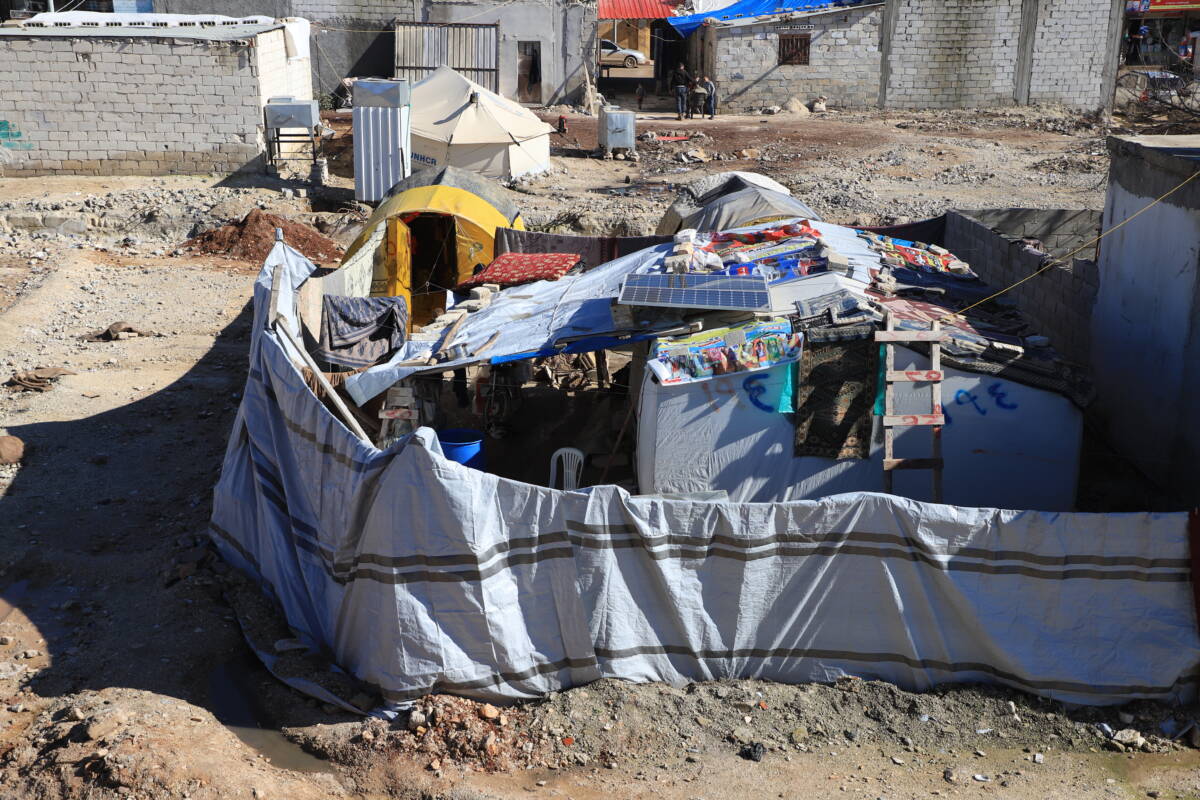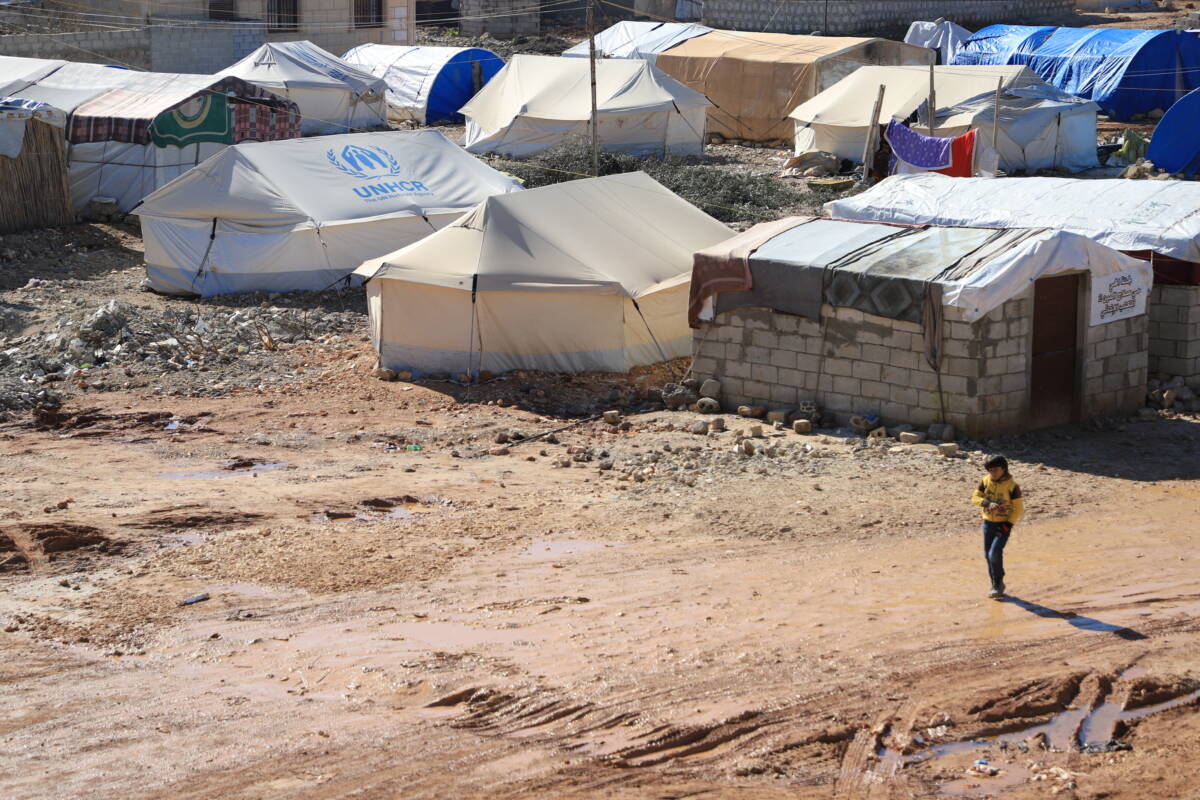With little support, thousands of Syrians homeless one year after earthquake
One year after the February 6 earthquake, tens of thousands of Syrian survivors are still homeless, without enough support to repair and rebuild their homes. Aid workers stress the importance of early recovery to facilitate returns and provide livelihoods.
6 February 2024
MARSEILLE, JENDERES — In the predawn darkness of February 6, 2023, the earth convulsed. A 7.8-magnitude earthquake in northwestern Syria and southeastern Turkey, followed by thousands of aftershocks, brought down buildings and buried tens of thousands of people under the rubble.
In Turkey, more than 44,000 people were killed and 2.2 million injured. In neighboring Syria, more than 4,500 people were killed and 8,500 injured, mostly in the opposition-controlled northwest. Rescuers there dug for survivors with little more than their hands, without sufficient equipment or help from international rescue teams as cross-border aid operations stalled for nearly two weeks.
In the initial aftermath of the earthquake, more than 100,000 Syrians were displaced after their homes, buildings weakened by years of conflict and faulty construction, collapsed. According to the United Nations (UN), around 1,900 buildings were completely destroyed, while 8,800 were partially damaged and rendered uninhabitable.
The Assistance Coordination Unit (ACU), a Syrian NGO that works to identify needs on the ground and coordinate aid delivery, told Syria Direct that the real number of damaged buildings is unknown, and likely much higher.
Read more: Earthquake, years of war make northwestern Syria’s buildings ‘graves above ground’
One year later, tens of thousands of survivors are among the 2.9 million people who are displaced in the opposition-held northwest. Many live in tents, some pitched on the rubble of their destroyed homes, especially in and around the towns hit hardest by the earthquake: Aleppo province’s Jenderes, and Idlib’s Harem and Salqin.
Ola al-Aloush, 26, and her 18-month-old daughter are among them. On February 6, she and her husband were at their home in Jenderes, where they had built a life after they were displaced from Aleppo city. When the earth shook, the building “collapsed to the ground,” she said. Her husband did not survive.
Like many of her neighbors, al-Aloush pitched a tent on the site of her destroyed home once the rubble was removed.“I don’t [even] have a carpet, I have one piece of furniture and one heater,” al-Aloush said. Without firewood, she burns plastic bags for warmth.
“My daughter and I only have God’s mercy,” al-Aloush said. “It’s been a year, and I haven’t seen any support, money or aid. No organization, no official body, no local council, nothing.”
Fully collapsed buildings, like al-Aloush’s, are not eligible for financial assistance provided by local organizations, Saleem Algerk, media coordinator at the aid organization Shafak, said. His organization offers an average of $600 for repairs to windows, doors, walls and floors. Al-Aloush estimated her home would cost $10,000 to rebuild.
“No rebuilding activities have taken place yet,” Qasim Yazigi, manager of the Information Management Unit of the ACU, told Syria Direct. Repairs have been undertaken for 15,354 homes in 88 communities that suffered minor or moderate damages during the earthquake, he said.
Around 40,500 people left homeless by the earthquake have been displaced to reception centers in northwestern Syria, Yazigi added. Others, like al-Aloush, are among an estimated 800,000 people stranded in tents.
Major international donors, which fund the work of organizations like Shafak, do not fund reconstruction in Syria, which is politically charged. Pending a political transition to end Syria’s more than decade-long war, donors like the United States and the European Union similarly do not fund homes destroyed by conflict, even as regime and Russian bombardment continues to pummel northwestern Syria.
Aid organizations and earthquake survivors in northwestern Syria say more support for reconstruction and infrastructure repairs is badly needed. In the meantime, while donors slash funding and need grows, thousands like al-Aloush are left trying to pick up the pieces.

Ola al-Aloush and her daughter sit close to the heater on a winter day in their tent in Jenderes, 1/27/2024 (Abd Almajed Alkarh/Syria Direct)
‘All promises’
While al-Aloush’s home is not eligible for support, others like Muhanid Muhammad, 43, have received small sums to repair their homes. Muhammad’s ground floor apartment in Harem was partially damaged by the earthquake, and he received $150 from People In Need, an international NGO, for repairs. He paid an additional $600-700 out of pocket.
But one year later, Muhammad’s apartment still needs more work. He estimates he needs up to $700 more to finish the repairs. With his monthly income of $100-150 working in a tire store, it is difficult to save up.
“The children are afraid of tremors or an earthquake, and don’t want to return home,” Muhammad added. In the meantime, he, his wife, and four children rent a place in a neighboring village for $75 a month—something the vast majority of displaced people do not have the means to do, according to Abdul Razzaq Awad, Northwest Syria Area Manager at Syria Relief.
“We are in a region that is in a constant state of crisis, so prices increase because there are not enough houses,” Awad said. Northwestern Syria is now home to 4.5 million people, a manifold increase from its prewar population, following successive waves of displacement. “Before the war there were about 152,000 people in Idlib. Today we are talking about a million without new construction,” he added.
Mustafa Mustafa, 28, has been unable to work since he was severely injured in the earthquake, leaving him unable to afford rent or rebuild his destroyed home. Originally from Syria’s coastal Latakia province, he fled to Salqin in 2021 to avoid military conscription, and lived with his family in a five-story building. When the earthquake hit, it collapsed.
“I spent around 12 hours beneath the rubble, with my father, my family,” Mustafa recalled. “My father died above me, immediately.” When Mustafa was pulled from the rubble, he spent a month in a hospital in Idlib, where he underwent seven surgeries. He now lives in a tent, a few kilometers away from where his family’s home once stood.
Mustafa has received $400 from Bonyan, a local NGO, and an additional $150 in emergency assistance, but no support to rebuild his destroyed home. There has been talk of reconstruction, but “these are all promises—until now, we haven’t seen anything,” he said.
Following risk assessments commissioned by local councils, some houses that were damaged by the earthquake but remained standing are being torn down, Algerk of Shafak said. Despite the risks, “some are residing in crumbling houses because they prefer that to tents,” he added. “They are accustomed to living in the city and it is difficult for them to go to a camp,” Awad echoed.

Ola al-Aloush’s tent in Jenderes, equipped with a solar panel, sits where her home once stood before it was destroyed by the February 6, 2023 earthquake, 1/27/2024 (Abd Almajed Alkarh/Syria Direct)
‘The sustainable solution’
In recent years, Syrian NGOs have increasingly voiced the need for sustainable solutions to basic needs arising from the conflict. They argue this must come in the form of increased early recovery programming.
“Early recovery is an approach that focuses on restoring key basic services that enable those affected by disaster to rely on themselves in a sustainable manner, rather than constantly relying on relief organizations to meet their basic needs,” explains Khaled Kabash, acting Programs Manager at Violet, a nonprofit that works in both humanitarian aid and early recovery.
The United Nations Development Program (UNDP) is one of the primary actors undertaking early recovery programming in Syria, including in response to last year’s earthquake. Of the $397.6 million needed for its earthquake recovery plan, $10.7 million still has not been funded.
In 2023, only 36 percent of the UN Humanitarian Response Plan for all UN aid agencies was funded. With an even steeper shortfall expected this year, the ability of the UN to respond to the continued fallout from the earthquake will be heavily constrained.
Relief actors on the ground report that the actual budget needed for an effective earthquake response is much higher than the UN’s allocated budget. Funding for housing rehabilitation is “insufficient,” Kabash said, despite needs “increasing day after day due to the continued, repeated bombing operations” by the Syrian regime and its ally, Russia.
Awad, of Syria Relief, estimates that 60 percent of damaged homes have been repaired, while less than 30 percent of destroyed homes have been rebuilt. As a result, most of those displaced by the earthquake have not been able to return, he said.
Rather than the UN or international organizations, private donors are the leading funders of rehabilitation projects, Awad said. Molham Volunteering Team, for example, raised 13.4 million for its earthquake response in northwestern Syria and southern Turkey, according to its website.
Awad classified international funding, such as that from the United States Agency for International Development (USAID), as the second source, followed by businessmen and local councils that coordinate rehabilitation activities. Local councils have also provided alternative housing in mobile homes and concrete housing blocks.
For fully destroyed homes, only private donations cover the costs. The US government’s Caesar Act restricts reconstruction funding until a political transition takes place according to UN Security Resolution 2254—and also provides for sanctions on non-US actors. The EU has a similar stance. Under such restrictions, response actors can only go as far as early recovery, but even that is limited.
“We, as organizations, always try to push in the direction of early recovery because that’s the sustainable solution, especially since we expect that there will always be cuts. However, international donors are not giving us free rein to do so,” Awad said.
Last month, the World Food Program (WFP) terminated all in-kind food assistance in Syria, where more than half of the population is expected to go hungry this year. More cuts are forthcoming according to humanitarian sources on the ground.
Read more: Syrians lose WFP lifeline as US slashes funding
Homes are not the only buildings in need of repair after last year’s earthquake. Water and sanitation facilities, schools, hospitals and government buildings were also damaged. Businesses were also destroyed, with far-reaching effects for people’s livelihoods.
“There is a need for greater intervention in restoration and reconstruction projects, as well as support for commercial activities, small projects and sustainable projects,” Algerk said.
Instead, emergency aid continues to be prioritized. Like Algerk, Awad said economic development, livelihoods support, and vocational training—alongside infrastructure projects—are the only sustainable way forward.
Mustafa’s injuries do not allow him to do manual labor, but he dreams of opening a small grocery store, if he had an investor. If he could work, he would have rebuilt his own home, he said. Muhammad felt similarly. With a proper wage, he “would not have waited” to repair his house, he said.
“Today, people are fed up with food baskets…they want work,” Awad said.







